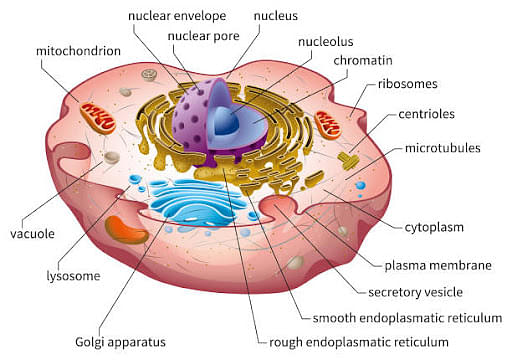Question:
What is common between chloroplasts, chromoplasts and leucoplasts ?
What is common between chloroplasts, chromoplasts and leucoplasts ?
Updated On: Aug 1, 2022
- Presence of pigments
- Possession of thylakoids and grana
- Storage of starch, proteins and lipids
- Ability to multiply by a fission-like process
Hide Solution
Verified By Collegedunia
The Correct Option is D
Solution and Explanation
Plastids are small bodies found free in most plant cells. These are found absent in fungi, certain bacteria, algae and multicellular animals. The plastids can be categorized to :
Chromoplasts : Coloured (other than green) plastids.
Chloroplasts : Green coloured plastids :
Leucoplasts : Colourless plastids.
All these three are double membrane bound structures which are mainly used for trapping radiation and storage purposes.
New plastids arise from proplastids by a fission like process.
Was this answer helpful?
0
0
Top Questions on Cell: the unit of life
- Which organelle is primarily responsible for producing ATP in a cell?
- MHT CET - 2025
- Biology
- Cell: the unit of life
- Which organelle in a eukaryotic cell is primarily responsible for synthesizing proteins destined for secretion?
- MHT CET - 2025
- Biology
- Cell: the unit of life
- Which of the following organisms or organelles contain 70S ribosomes?
- MHT CET - 2025
- Biology
- Cell: the unit of life
- Which term is used for cells performing similar functions and cells collecting intracellular material?
- AIIMS - 2024
- Biology
- Cell: the unit of life
- What is the movement of cytoplasm within a cell called?
- MHT CET - 2024
- Biology
- Cell: the unit of life
View More Questions
Questions Asked in AIIMS exam
- 1028 grams of seawater sample contains 7 mL of dissolved oxygen ($ \text{O}_2 $). What is the concentration of oxygen in parts per million (ppm)?
- AIIMS - 2024
- Environmental Chemistry
- Explain why ortho-nitrophenol is more steam volatile than para-nitrophenol.
- AIIMS - 2024
- Hydrogen Bonding
- Two blocks of mass \( 20\,\text{kg} \) and \( 30\,\text{kg} \) are placed in contact on a smooth horizontal surface. A force \( F = 60\,\text{N} \) is applied to the \( 20\,\text{kg} \) block. Find the force exerted by the \( 20\,\text{kg} \) block on the \( 30\,\text{kg} \) block.
- AIIMS - 2024
- Newton's Laws of Motion
- Which of the following is a globular protein?
- AIIMS - 2024
- Biomolecules

What is the correct IUPAC name for the following compound?- AIIMS - 2024
- Organic Chemistry - Some Basic Principles and Techniques
View More Questions
Concepts Used:
Cell: The Unit of Life
- A cell is derived as the functional and structural unit of life. Every cell is surrounded by a cell membrane that dissects the external and internal environments of the cell. The interior environment of a cell is called the cytoplasm.
- It carries cellular machinery and structural elements. The nucleus is present in the center of the cell, which includes all the hereditary information of an organism. Some of the molecules present in the cell are protein, carbohydrates, starch, and sugar.
Read More: Fundamental Unit of Life: Cell
Parts of Cell:
The different parts of a cell and their functions are as follows:
- Cell Membrane
- Cell Wall
- Nucleus
- Cytoplasm
